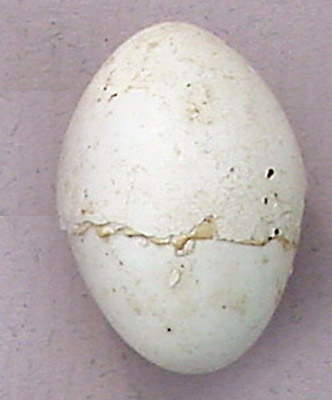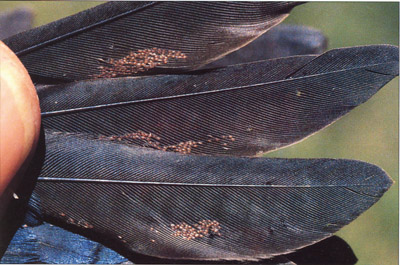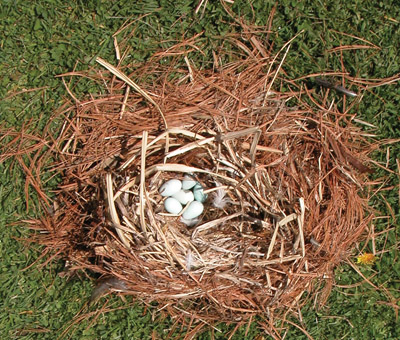Troubleshooting Problems
By conducting weekly nest checks and doing daily walks around the colony site you can more easily detect and hopefully prevent problems from happening. Here are a few of the issues you may find at your Purple Martin colony and how to solve them.
Capped Eggs: Half of a hatched eggshell is stuck onto an unhatched egg. The nestling in the capped egg will die if it cannot break through the extra shell. The cap can be carefully removed and the egg may still hatch if discovered soon enough.

Unhatched Eggs: if eggs are more than a week past hatch date, and remaining eggs have hatched, they can be removed. If new eggs are added to a clutch of unhatched eggs, wait until hatching is complete, then remove unhatched eggs when young are a week old.
Parasites: Nest mites are most common. Northern landlords may also find blowfly larvae. Do not spray housing with insecticide or cleaning products. Place nestlings in bucket and cover it, remove nest material, wipe inside and outside of compartment with a damp paper towel. Add new nest material and replace nestlings.

Dead Adult or Nestling: Remove, check for signs of pecking by House Sparrows or starlings. Replace nest material if it is wet or full of maggots.
Non-native Nest: Remove nest, place trap in compartment if possible, such as Universal Sparrow Trap, Spare-O-Door trap, etc. If you have a lot of problems with starlings, consider converting to starling-resistant entrances.

Native Nest: Leave in place if it contains eggs or nestlings. Place alternate housing nearby for them to use for next brood. Remove incomplete nests and place in alternate housing. *For more information about starlings and House Sparrows please visit Non-native Competitors.
Signs of Predators
Snake: Remove from house and release a few miles away. Add pole guards if you didn’t have them installed to begin with, or add a net snake trap above guard if the snake bypassed the guard.
Raccoon: Finding severed martin wings on the ground is a sign of raccoon predation. Make sure your pole guard is mounted at least 4 ft. above ground level.
Owls/Hawks: Finding owl feathers below housing or piles of plucked martin feathers in your yard is a sign of avian predation. Add external cage guards.
*For more information on predators and how to prevent attacks please see Predation
Premature Fledglings: Nestlings may fledge prematurely before they are 26 days old for several reasons: overcrowding, nest parasites, hot temperatures. If you find a nestling on the ground, lower down the housing, check your records to see which cavity they came from and return them. If you do not know where the nestling came from, lower down the housing, and place the nestlings in a cavity that contains 4 or fewer nestlings that are the same size.
Hot Weather: Add shading and ventilation to your martin housing. Provide supplemental food if there is also a drought.
Cold Weather: Add insulation to martin housing. Provide supplemental food
*For more information please see Weather and Supplemental Feeding
Recommended Reading:
What's Bugging Your Birds
Dealing with Blackflies
Injured Purple Martin?
Controlling House Sparrows and Starlings Humanely
Controlling House Sparrows
House Sparrow Myths
